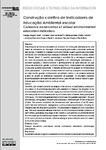Mostrar o rexistro simple do ítem
Construção coletiva de indicadores de educação ambiental escolar
| dc.contributor.author | Reiguel Vieira, Solange | |
| dc.contributor.author | Lopes de Morais, Josmaria | |
| dc.contributor.author | Torales Campos, Marília Andrade | |
| dc.date.accessioned | 2019-04-02T11:29:59Z | |
| dc.date.available | 2019-04-02T11:29:59Z | |
| dc.date.issued | 2017 | |
| dc.identifier.citation | Ambientalmente Sustentable, 2017, 23-24: 387-391. ISSN: 1887-2417 | es_ES |
| dc.identifier.issn | 1887-2417 | |
| dc.identifier.uri | http://hdl.handle.net/2183/22465 | |
| dc.description.abstract | [Resumo] Esta pesquisa apresenta uma análise do processo de construção participativa de uma matriz de indicadores de Educação Ambiental (EA) para avaliar a dimensão ambiental das escolas. O trabalho foi realizado envolvendo oitenta e quatro sujeitos da comunidade escolar de nove escolas públicas estaduais localizadas no município de Curitiba, estado do Paraná, Brasil. O caminho metodológico escolhido foi a abordagem qualitativa por meio da pesquisa documental, bibliográfica e de metodologias participativas. O processo subsidiou o desenvolvimento e aperfeiçoamento de uma matriz de EA, que possui três dimensões: gestão, currículo e espaço físico, contemplando dez indicadores e cinquenta questões descritoras. O trabalho desenvolvido foi avaliado de forma positiva pelos participantes. O processo permitiu reflexões sobre as condições socioambientais de cada escola, gerando conhecimento do trabalho coletivo e da temática ambiental a partir do desafio de estabelecer indicadores de avaliação. Os resultados indicaram as potencialidades da ferramenta para promover uma reflexão coletiva visando a ação-reflexão-ação em relação a EA no contexto escolar. | es_ES |
| dc.description.abstract | [Abstract] Therefore, this research presents an analysis of the process of participatory construction of a matrix of Environmental Education (EE) indicators to measure the progress of the environmental dimension of schools. Eighty-four persons from the school community of nine state public schools located in the city of Curitiba, state of Paraná, Brazil, participated in the study. The methodological approach chosen was the qualitative approach. We used documentary, bibliographic research and participative methodologies for the production of data. The process subsidized the development and improvement of an EE matrix, which has three dimensions: management, curriculum and physical space, including ten indicators and ffty descriptive questions. The participants evaluated the work in a positive way. The work developed allowed refections on the socio-environmental conditions of each school, generating knowledge of the collective work and the environmental theme from the challenge of establishing evaluation indicators. The results indicated the potential of the tool to promote a collective refection aiming at action-refection-action in relation to EE in the school context. | es_ES |
| dc.language.iso | por | es_ES |
| dc.publisher | Universidade da Coruña, Servizo de Publicacións | es_ES |
| dc.rights | Atribución-CompartirIgual 3.0 España | es_ES |
| dc.rights.uri | http://creativecommons.org/licenses/by-sa/3.0/es/ | * |
| dc.subject | Espaços educadores sustentáveis | es_ES |
| dc.subject | Escolas sustentáveis | es_ES |
| dc.subject | Indicadores | es_ES |
| dc.subject | Metodologias participativas | es_ES |
| dc.subject | Sustainable educative spaces | es_ES |
| dc.subject | Sustainable schools | es_ES |
| dc.subject | Indicators | es_ES |
| dc.subject | Participatory methodologies | es_ES |
| dc.title | Construção coletiva de indicadores de educação ambiental escolar | es_ES |
| dc.title.alternative | Collective construction of school environmental education indicators | es_ES |
| dc.type | info:eu-repo/semantics/article | es_ES |
| dc.rights.access | info:eu-repo/semantics/openAccess | es_ES |
| UDC.journalTitle | AmbientalMente Sustentable: Revista científica galego-lusófona de educación ambiental | es_ES |
| UDC.volume | 23-24 | es_ES |
| UDC.startPage | 387 | es_ES |
| UDC.endPage | 391 | es_ES |
| dc.identifier.doi | https://doi.org/10.17979/ams.2017.01.023-024.3391 |






